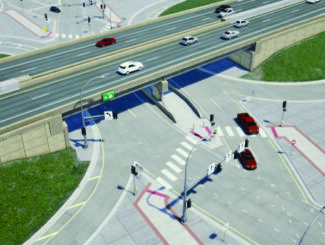July 18, 2023
By Jessica Dugger, Contract Support Lead
Disrupting the traditional process
Machine control modeling has been part of the construction industry for over twenty years, but as the industry faces supply chain challenges and a lack of available labor, the need to streamline and create efficiencies is only increasing. As designers, contractors and teams strive to complete projects efficiently and accurately, new innovations and approaches are changing the way the industry is approaching machine control modeling.
In a traditional approach to machine control modeling, a contractor will receive 2D design information that has to be recreated in 3D. Although there are many benefits that result from this process, there is still too much room for human error, a lack of conflict identification and unbalanced earthwork quantities.
From 2D to 3D
As digital delivery methods continue to drive our industry, our goal is to migrate away from having 2D plans for construction. In many cases, working off a 2D plan and a 3D model can be controversial, causes confusion and is contradictory. A deep understanding of the needs of contractors, owners and designers allows us to develop one true source of design information in a 3D model that streamlines the process. Through cutting-edge tools combined with our expertise, we develop a 3D model that is useable in the field for grading model systems. This is just one of the many construction benefits of developing a single source of truth in a 3D model. The 3D model serves as the foundation for all information needed to deliver a project because of its accuracy and end user capabilities.
The top ways design firms are changing the way contractors approach machine control.
Custom Machine Control Files
Contractors have unique needs. They rely on accurate models because it replicates exactly what needs to be built. To support this, we develop custom machine control files that eliminate contractor conversions and modifications. These custom files are usable in Trimble, TopCon and LEICA contractor systems.
Validation of the 3D design on both sides
The use of a 3D model allows for the validation of information within the design platform and the contractor platform (TBC, Magnet) eliminating the need to rerun earthwork. A high-quality 3D model improves project outcomes. Oftentimes, owners will use a 3D design model instead of a standard design model because of the significant benefits. In any construction project, expectations of a contractor are high. A 3D model ensures accuracy and eliminates construction failure or a perception of cut corners from the owner.
Identify errors immediately
When contractors work directly with a team that has a deep understanding of design and field needs, the process is significantly streamlined and more accurate. Once a 3D model is created, errors are identified even after the bid process, providing a more accurate building process before construction even begins.
Relying on models to guide the project
Layout models match grading models. With one mode, there are less surprises in the field. A model also reduces the manhours and survey supplies needed. In the past, a surveyor would layout ‘whiskers’ every 50-feet. A model eliminates this need, resulting in smoother roads and less cording. In addition, communicating with an owner becomes easier. Owners want to see the completed surface model look exactly like the design. A 3D model aids in communication and collaboration.
Reduce costs and staff
With greater confidence in grading model accuracy, the changing landscape of operator ability won’t have an impact on projects. There is less skill required when working with one true source of information. Additionally, with a high-quality 3D model, there is a less likely chance that work progress will not match up. Using this advanced design technology prevents accusations of poor construction, also eliminating the possibility of additional costs to fix issues forced onto the contractor.
Increase sustainability
Exact quantities and information results in the reduction of materials. Contractors are reliant on a 3D model because they are paid based on the volume of materials calculated by the model. With the model, quantities are precise, eliminating the small extra quantities in the corners that add up quickly. An accurate 3D model prevents an excess or shortage of materials.
Jessica Dugger is a contractor support lead. With over 15 years of experience in both design and construction fields, Jessica has a strong background in the AEC industry. She demonstrates her expertise in many areas including MicroStation, InRoads, Google Earth, Trimble Business Center, Virtual Design, machine control and survey.


